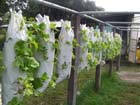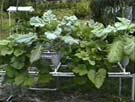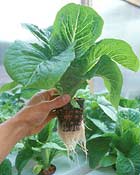Hydroponic Drip Systems
Drip systems are one of the most widely used types of hydroponic systems around the world, both for home growers as well as commercial growers alike. That's mainly because it's an easy concept and needs few parts, but yet it's a very versatile and effective type of hydroponic system. Even though it's an easy concept, it won't limit your imagination when building your own systems. The way a drip system works is just like it sounds, you simply drip nutrient solution on the plants roots to keep them moist.
 Hydroponic
drip systems can easily be designed in many ways, as well as from small
to large systems. But their especially useful for larger plants that
take a lot of root space. That's because you don't need large volumes
of water to flood the system, and the drip lines are easy to run over
longer spaces. As well as when using a larger amount of growing media
for larger plants, more growing media retains more moisture than
smaller amounts, and that's particularly beneficial to large plants
because it's more forgiving to the plants. Forgiving meaning that the
plants arent as sencitive to watering times, so they don't stress
imeditaly if they don't get waterd on time for one reason or another.
Hydroponic
drip systems can easily be designed in many ways, as well as from small
to large systems. But their especially useful for larger plants that
take a lot of root space. That's because you don't need large volumes
of water to flood the system, and the drip lines are easy to run over
longer spaces. As well as when using a larger amount of growing media
for larger plants, more growing media retains more moisture than
smaller amounts, and that's particularly beneficial to large plants
because it's more forgiving to the plants. Forgiving meaning that the
plants arent as sencitive to watering times, so they don't stress
imeditaly if they don't get waterd on time for one reason or another. What you'll need to build a drip system is:
- A container for the plant's roots to grow in.
- A container (reservoir) to hold the nutrient solution.
- A submersible fountain/pond pump.
- A light timer to turn the pump on and off.
- Some tubing to run from the pump in the reservoir to the plants (and/or the drip lines if you use different sizes).
- Tubing (PVC or flexible tubing) to run the return lines for the extra nutrient solution from the plants back to the to the reservoir.
- (optional) You can use drip emitters, or you can just poke small holes in the tubing with a hot paper clip for the nutrient solution to drip out of like we like to do.
- Growing media for the plants roots to grow in and help support the plants weight.
There are really two types of hydroponic drip systems
Recirculating/recovery drip systems
For home growers the recirculating drip systems are by far the most commonly used. The recirculating drip systems is like it sounds, it simply refers to reusing/cycling the used nutrient solution after it has wet the roots back to the reservoir where it can be recirculated through the system, and used over and over again. Recirculating systems are also called recovery systems because it refers to recovering the used nutrient solution so it can be recirculated through the system again.
Like any hydroponic system that recirculates, a recirculating drip system's nutrient solution can change in both the pH as well as nutrient strength levels as the plants use up the nutrients in the water when it circulates over and over. Because of this, recirculating systems require that you periodically check and adjust the pH as needed, as well as change the nutrient solution regularly to maintain a balanced nutrient solution for the plants.
Non-recirculating/non-recovery drip systems
For commercial growers the non-recirculating/non-recovery drip systems are most common. While it sounds like a waist of water and nutrients not to recover and reuse it, commercial growers actually waist very little. They do this by precisely timing their watering cycles. Using special "cycle timers" they can adjust the watering times down to the minute, or even second if they need to. They water just long enough to wet the growing media. So the water (nutrient solution) they drip onto the plants is absorbed and held in the growing medium where the plants roots access it, and very little if any runs off. From time to time they flush the growing medium with plain fresh water to avoid nutrient build up in the growing medium over time.
The nutrient solution in non-recirculating/non-recovery drip systems tend to be less maintenance, mainly because of the fact that none of the used nutrient solution is recycled back into the reservoir. This means that you can fill the reservoir with a balanced, pH adjusted nutrient solution and it won't change, so you don't need to keep monitoring it. As long as you keep the water in the reservoir slowly moving/circulating so that the heavier mineral elements don't settle at the bottom, it will remain a balanced pH adjusted nutrient solution.
For home growers the recirculating drip systems are by far the most commonly used. The recirculating drip systems is like it sounds, it simply refers to reusing/cycling the used nutrient solution after it has wet the roots back to the reservoir where it can be recirculated through the system, and used over and over again. Recirculating systems are also called recovery systems because it refers to recovering the used nutrient solution so it can be recirculated through the system again.
Like any hydroponic system that recirculates, a recirculating drip system's nutrient solution can change in both the pH as well as nutrient strength levels as the plants use up the nutrients in the water when it circulates over and over. Because of this, recirculating systems require that you periodically check and adjust the pH as needed, as well as change the nutrient solution regularly to maintain a balanced nutrient solution for the plants.
Non-recirculating/non-recovery drip systems
For commercial growers the non-recirculating/non-recovery drip systems are most common. While it sounds like a waist of water and nutrients not to recover and reuse it, commercial growers actually waist very little. They do this by precisely timing their watering cycles. Using special "cycle timers" they can adjust the watering times down to the minute, or even second if they need to. They water just long enough to wet the growing media. So the water (nutrient solution) they drip onto the plants is absorbed and held in the growing medium where the plants roots access it, and very little if any runs off. From time to time they flush the growing medium with plain fresh water to avoid nutrient build up in the growing medium over time.
The nutrient solution in non-recirculating/non-recovery drip systems tend to be less maintenance, mainly because of the fact that none of the used nutrient solution is recycled back into the reservoir. This means that you can fill the reservoir with a balanced, pH adjusted nutrient solution and it won't change, so you don't need to keep monitoring it. As long as you keep the water in the reservoir slowly moving/circulating so that the heavier mineral elements don't settle at the bottom, it will remain a balanced pH adjusted nutrient solution.




